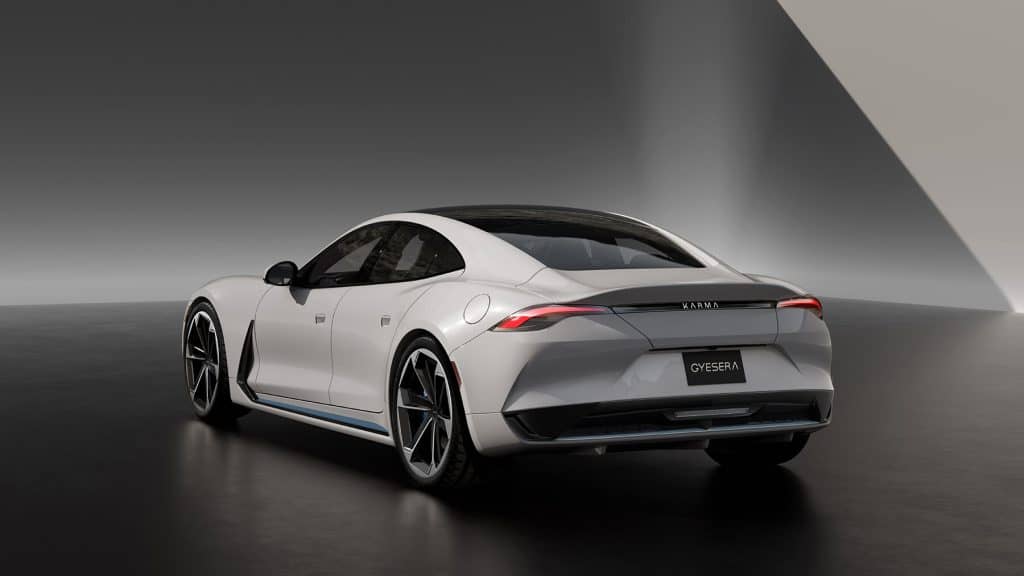
Karma Automotive has pulled the wraps off its latest statement piece, the 2026 Karma Gyesera Grande Coupé, a car that aims to carry forward the marque’s reputation for individualistic design while reasserting its place in the evolving hybrid luxury segment.
Its first full public showing at Monterey Car Week 202 during The Quail: A Motorsports Gathering on Friday, August 15—the Gyesera promises to combine style, performance, and innovation in equal measure, setting the tone for the next generation of Karma products.
For those who remember the company’s earlier effort, the Karma Revero, the Gyesera stands as both a spiritual successor and a clean-sheet rethink. More than a decade ago, the Revero carved out a niche by pioneering the plug-in luxury hybrid category, well before mainstream automakers fully embraced electrification. In that sense, the Gyesera doesn’t merely replace the Revero—it builds upon its legacy, updating the formula with lighter materials, modern software integration, and sharper performance.
Underneath its sculpted bodywork lies an evolution of Karma’s all-aluminum space-frame architecture. To save weight, nearly every body panel is fashioned from a mix of aluminum and carbon-reinforced composites, including the hood, roof, fenders, rockers, and rear diffuser. Beyond shedding pounds, these materials allow for crisper lines and a more planted stance, while improving torsional rigidity and crash performance. The car’s proportions—long hood, low roof, and wide track—reinforce its Grande Coupé identity.
Finished in Newport Grey Mist for its Monterey debut, the Gyesera sits on lightweight 22-inch forged billet aluminum wheels shod with Karma-specific Pirelli tires. The staggered fitment (245/40 front, 265/40 rear) aims to balance cornering grip with reduced rolling resistance, a nod to both performance and long-distance cruising efficiency. Design details matter here. Piano black rocker inserts trace into the front fenders to form the brand’s new “Backslash” signature, framing the model designation. Lighting also plays a starring role: Karma’s so-called “Target Acquisition” lighting theme, first seen on the Kaveya super-coupé concept, now appears in production guise across the Gyesera’s hood, fascia, and running lamps. Even the hood vent has been styled with meaning, its “Comet Line” profile evoking a celestial body streaking across the night sky—while also serving the practical role of directing cool air into the engine bay.
The Gyesera will be offered with the latest iteration of Karma’s hybrid extended-range electric vehicle (EREV) powertrain. Output is rated at 566 horsepower and 546 lb-ft of torque, enough to shove the 4-place coupé from 0–60 mph in just four seconds flat. That figure marks a half-second improvement over the outgoing Revero, underscoring the car’s claim to be faster, lighter, and more technologically advanced than its forebear.
Pricing is set to begin around $165,000, with production scheduled to start in the fourth quarter of 2025. Notably, the Gyesera will be joined by a more expensive stablemate—the Amaris GT Coupé—sometime in 2026, which will wear a sticker closer to $200,000. Both models will form the core of Karma’s luxury hybrid lineup moving forward, eventually to be joined by even more exotic offerings such as the Kaveya super-coupé and Ivara GT-UV.
What distinguishes the Gyesera from many of its peers is not only its hardware but also the way it was conceived. Karma has adopted what it calls its Intelligent Product Development System (IPDS), borrowing heavily from the tech industry’s use of “digital twins.” This system allowed Karma to virtually model, test, and refine the Gyesera in a digital environment before physical prototypes were built.
According to President and CEO Marques McCammon, the approach was designed to reduce development time, increase robustness, and make the company more resilient. That doesn’t mean traditional craftsmanship has been abandoned. On the contrary, Karma leans heavily on its California-based Karma Innovation and Customization Center in Moreno Valley, where each car is built. The blending of cutting-edge virtual tools with hands-on assembly echoes the broader philosophy of the company: to combine the discipline of established automotive engineering with the boldness of the startup and technology worlds.
The interior of the Gyesera underscores this balance between tradition and technology. Trimmed in new “Moondust” leather with “Atmosphere Blue” accents, the cabin is an exercise in restraint. Rather than overwhelming occupants with oversized touchscreens, Karma has chosen a more measured approach, integrating slim digital displays as accents to the overall design. A Qualcomm 8155-based cockpit controller powers the system, while “Target Acquisition” graphics carry the brand’s visual identity into the digital realm.
The HVAC system has been neatly integrated behind slim metal trim, and control menus cascade logically, prioritizing ease of use. Wireless CarPlay and Android Auto come standard, while over-the-air (OTA) update capability allows Karma to continuously add new features. Among these is “Tune,” an equalization package developed with high-end audio company Master & Dynamic, as well as predictive diagnostics driven by machine learning. Practical touches abound, too. A wireless charger hides beneath the armrest, USB-C ports serve both rows of seats, and redesigned front chairs yield 15 percent more rear legroom than before. A backlit start button and jewel-like key fob presentation serve as reminders that despite its reliance on tech, this is still very much a luxury automobile.
Karma Automotive occupies afascinating place in the modern car world. Based in Southern California, it remains the only U.S. automaker focused exclusively on ultra-luxury hybrid extended-range vehicles. Its earlier models, while limited in volume, earned a following among enthusiasts who appreciated their individuality and California design ethos. Now, with the Gyesera, Karma is signaling that it intends not just to survive but to thrive, with a full lineup that stretches into the next decade.
McCammon describes the Gyesera as “the first page in the new chapter of Karma vehicles,” and that assessment may not be far off the mark. With its combination of advanced materials, electrified performance, and carefully curated interior design, the Gyesera represents an attempt to reclaim leadership in a niche Karma itself helped invent.